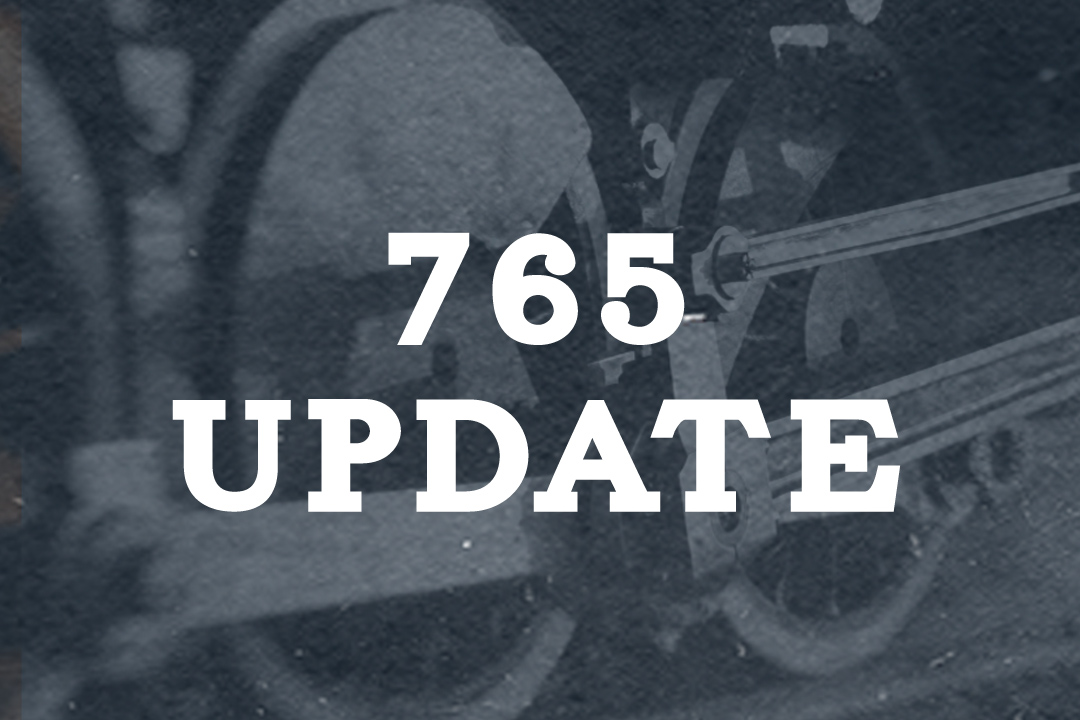Submitted by Steve Winicker.
LAST WEEKENDS SHOP ACTIVITY
Friday was spent looking for contractors and with Jerrad’s assistance getting the bell and the feedwater heater back in place. John had done some welding up of the spring rigging parts so I did a bit of work on those as well.
Saturday, we worked on getting oil lines off the trailing truck. Due to rain and crane issues we are waiting until next week to flip over the truck and measuring it for tramming the axles. The rest of the feed water heater was reassembled. Matt Lee worked on welding up the spring rigging parts that were worn.
Sunday Matt finished welding up the spring rigging parts and I did some more grinding and shaping of the spring hanger stirrups.
UPCOMING ACTIVITIES
Continued work will be done on the trailing truck frame and if the weather and equipment cooperate, we can flip it over and check the tram. Hopefully we will get some of the holes bored on the spring rigging parts. There is a list of other maintenance projects to pursue as well.
SAFETY SENSE
This is a good time of the year to review some basic safety tips associated with downed utility lines.
Power lines can come down as a result of windstorms, ice buildup, and motor vehicle accidents and sometimes misguided tree trimming activities. You cannot tell if a downed power line is energized just by looking at it. There may not be any sparks or movement of the downed wire. Even if the line is not live one moment, utility switching equipment may restore power to the line without warning. The protective covering on a power line is not insulation, it only protects the line from the weather. It won’t protect you from an electrical shock if contact is made with the line.
The electricity in a power line always seeks a path to the ground. This path might include a tree, a vehicle, or a fence. These objects then become energized. If you touch the energized line or object, the electricity can flow through your body thus causing electrocution and possibly death. Keep away from any object that is in contact with a power line.
Observe the yellow protective barrier tape which public safety or utility workers have placed around a downed wire location. Do not, under any circumstances, cross the yellow barrier tape. Better yet, stay as far away from the taped off area as possible. Any yellow barrier tape means ‘Stay Back and Do Not Cross’. Do not approach any downed line any closer than 20 feet if a yellow barrier tape has not been strung. Don’t assume that a line is dead if a yellow barrier tape hasn’t been applied. Public service or utility personnel may not have made it to the site yet or haven’t been notified. Call 911 to alert authorities of the downed wire.
Once electricity reaches the ground, the ground itself becomes energized. This can happen if a broken power line falls to the ground or onto a tree or fence. The electricity then flows through the ground over a wide area, spreading out like ripples in a pool of water. The voltage in the ground is very high at the point of electrical contact. Farther away, the voltage drops off. Stay away and call 911.
· Never, under any conditions, assume a downed line is not energized.
· Never, under any conditions, assume a downed line is a harmless cable TV, telephone or fiber optic line.
· Treat downed power lines and anything in contact with them as energized. Stay far away from any downed line.
· Call the power company and 911 immediately to report a downed line. A utility or public safety crew with proper training and equipment will respond as soon as possible to install barrier tape, physically guard the site or repair the downed line.
· Wait for the power company representative to confirm that it is safe to approach the scene and all barrier tape has been removed.
This is the season where severe weather can strike at any time. Following proper safety practices before, during and after the storm will minimize the chances of personal injuries or worse.
SAFETY IS JOB 1
SAFETY FIRST ALWAYS


